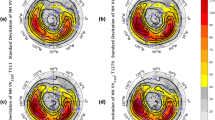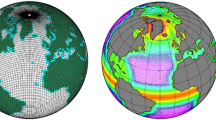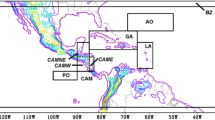Abstract.
The ECHAM4 general circulation model was tested for its skill in reproducing the sensitivity of the general circulation to the rotation rate of the Earth. The experiments have been designed to investigate the behavior of the model under conditions that are not typical of the parametric regime under which the model has been developed. The model was set at spectral T30 resolution, has 19 vertical levels and it includes a rather complete set of physical parametrizations, seasonal and diurnal cycles, and a mixed layer ocean. The other parameters have been prescribed at present climate values to offer a good comparison with the simulation of the present climate (24 h rotation rates). In particular, the present land–sea mass distribution and mountain ranges have been used. The dynamical response to rotation rate changes was investigated by performing sensitivity experiments at fixed rotation rates, from 18 to 360 h, each integrated for 20 years. The latitudinal extent and the strength of the Hadley Cell increased as the rotation rate was decreased, as expected from idealized models and theory. The tropospheric jets underwent a similar evolution, moving poleward and modifying their intensity, as the rotation rate was decreased. The winter stationary waves have been found to be very sensitive to the rotation rate, turning into longer and longer wavelength quickly as the rotation slowed. The model has been also used to investigate the stability of the general circulation to the variations of the rotation rate. The model was run with a rotation period of 240 h and a direct Hadley Circulation equator to pole was observed. The rotation rate was subsequently increased until baroclinic instabilities at midlatitudes appeared. The experiment demonstrated how ECHAM4 handles the unstable character of the eddy-free circulation typical of slow rotations and the transition to turbulent, eddy rich, regimes. The overall results indicate that rotation rate changes need to be taken into account when designing paleoclimatic simulations. The good agreement between the results of the simulations and the bounds provided by the dynamical theories of the general circulation enhances our confidence in the capability of the model to represent the general circulation in different situations from the present climate.
Similar content being viewed by others
Author information
Authors and Affiliations
Additional information
Electronic Publication
Rights and permissions
About this article
Cite this article
Navarra, .A., Boccaletti, .G. Numerical general circulation experiments of sensitivity to Earth rotation rate. Climate Dynamics 19, 467–483 (2002). https://doi.org/10.1007/s00382-002-0238-8
Received:
Accepted:
Issue Date:
DOI: https://doi.org/10.1007/s00382-002-0238-8




